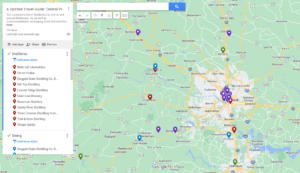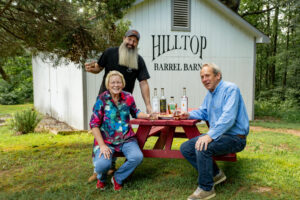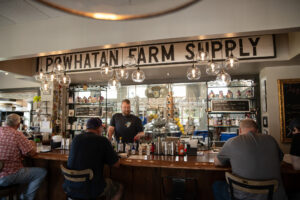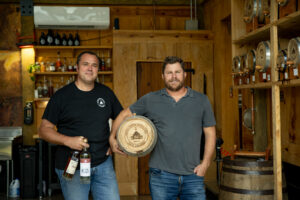So, we’ve already shared a deep dive on whiskey in the commonwealth (read it here), but what about just bourbon? Maybe you’re a connoisseur and don’t need the play-by-play, but if you’re a casual sipper or just curious, here’s what you need to know.
Whiskey is the top produced spirit in Virginia with just about 50 producers spanning the state. Bottle to bottle, you’ll find a great variance in flavor profiles, style, aging and more – down to the balance of its very ingredients (or in this case, grains).
All bourbon is whiskey, but not all whiskey is bourbon.
In order for a whiskey to be called bourbon, it must be made from a mash that is at least 51 percent corn and aged — for no particular amount of time — in new, charred oak barrels.
One way these requirements can manifest in the bottle is how sweet or smooth the whiskey is. For example, a higher percentage of corn typically makes the end result sweeter. The specific type of barrels used for aging also tends to introduce a distinct flavor and smooth, velvety mouthfeel.
Keep reading for the rundown on how to make, shop, store and enjoy Virginia bourbon.
How to Make
All whiskey starts as raw grain (corn, barley, rye or wheat) before it finds its way into a bottle. Details like where the grain was grown (read about terroir), the water used in the distillation process, and how and how long it ages all matter and come together to make the final, unique product. The technical process itself is complex and nuanced, but here are the basics:
- Mashing: The sugars contained in the grain have to be separated before fermentation can begin. The grains that are being used are ground up, put in a large tank (called a mash tun or tub) with hot water and agitated. It should resemble porridge before the fermentation stage.
- Fermentation: Fermentation occurs when the mash meets yeast, which converts all the sugars into alcohol. This takes place in giant vats, often called washbacks. The process can take a few days, with different fermentation times and yeast strains all impacting the final product. The resulting liquid reaches about 7-10% ABV before it goes into the still.
- Distillation: The process of distilling increases the alcohol content of the liquid and brings out volatile components, both good and bad. The two most common types of stills (pot stills and column stills) determine how this all happens.
- Maturation: Nearly all whiskies are aged in wood — and for bourbon, it must be aged in new, charred oak barrels. Then, batches are stored away and left to age for as long as the producer decides.
- Bottling: When it’s ready, bourbon is bottled at a minimum of 40% ABV. When only one barrel is bottled at a time, it’s labeled as single cask or single barrel — always an exciting prospect when shopping Virginia whiskies.

*If you’re interested in making your own imbibe, you must follow Virginia codes and regulations. Licenses may be required.
The Virginia Way
First, it should be known that Virginia is the Birthplace of American Spirits, and that includes bourbon.
“The exact date of when Bourbon was invented is greatly debated, but most put it around the 1780s,” said David Bock, master distiller at A. Smith Bowman Distillery. “Virginia became a state in 1788, while Kentucky didn’t become a state until 1792. Prior to becoming a state, Kentucky’s land was part of Virginia, so the roots of bourbon making are forever tied to Virginia’s history.”
Bock – after coming to A. Smith Bowman Distillery from New Orleans as head distiller – has learned the legacy better than most.
In 1934, A. Smith Bowman established a distillery on the 7,200-acre Sunset Hills farm in Fairfax County as a way to put to use excess grains. Until the 1950s, A. Smith Bowman Distillery was the only legal producer of spirits in Virginia. The distillery has since relocated to Fredericksburg (in 1988), but it carries with it a storied history of bourbon-making and excellence.
“I often consider Virginia Bourbon a “hidden gem” as it doesn’t get the notoriety… but we’re honoring a craft and tradition that has been part of this state for centuries,” Bock said.
Another misperception is that bourbon has to be made in Kentucky. Spoiler alert: it actually can be produced anywhere. And Virginia is uniquely positioned to make great bourbon.
“Corn grows so well in Virginia, and I think that leads to more production of bourbon than other whiskeys like single malts and rye,” said Owen King, distiller at Ironclad Distillery in Newport News. “Also, Virginia has huge temperature swings that really help the bourbon mature nicely and at a greater rate.”
King also pointed out that people are fierce fans of bourbon, “I love Virginia bourbon, it’s all we produce. Bourbon was the first thing the federal government food and drug admiration protected – I find it fascinating that when the government tried to tax whiskey it caused a rebellion. Virginia bourbon is unique and special and can go toe-to-toe with any other state.”
So, why doesn’t everyone produce bourbon if it’s one of the state’s most beloved spirits and so well suited for Virginia?
Justin Boyle, distiller at Tarnished Truth Distilling Company in Virginia Beach, says it may have to do with the strict regulations on the spirit and the cost to produce an aged spirit.
“Bourbon is one of the most regulated spirits in the world,” Boyle said. “It also can take up resources and require an expensive overhead cost to produce a spirit that has to age in oak for years before it reaches maturity.”
But he also points out that the tedious endeavor to create something you want to taste the same year-to-year – given all the different variables that might lend to different flavors, grain, fermentation, distillation and aging – is what keeps him excited.
“To me, Virginia bourbon is the quintessential American spirit. It embodies all the characteristics of life, liberty and the pursuit of happiness (even if it’s a brown liquid in a glass). We are following a time honored tradition of making a specific spirit to exactness. We are aging it the traditional way in 53-gallon casks. We, at Tarnished Truth, have the Atlantic salty air that permeates our barrels. We like to say our barrels are “agitated by freedom” as the U.S. Navy jets fly overhead.”
Many distilleries across the state have turned this time-honored tradition into success, striking gold and double gold at competitions across the world. One competition, a little closer to home and respected for its results and a great time, is the Virginia Bourbon Invitational hosted by Tarnished Truth.
This annual (currently six-time), bourbon-exclusive event is hosted on an early Saturday in November. In 2024, 18 distilleries participated in a judges blind tasting, with the top three big winners being:
- Reservoir Distillery Hazmat Bourbon
- KO Distilling Distiller’s Reserve Bottled-in-Bond Bourbon
- Chesapeake Bay Distillery Bay Bourbon
“We host local distilleries to give them a platform to shine to an audience they might never reach,” Boyle said. “This year’s competition highlighted how much Virginia bourbons are improving and growing, culminating in the absolute best version yet. The blind judges even remarked how much the distilleries have matured and improved on their flavors, their aging and their ingenuity.”

How to Shop
If you’re lucky enough to live in Virginia, a.k.a the Birthplace of American Spirits, you have no shortage of options when it comes to bourbon. (And if you don’t, luckily, many distilleries ship out-of-state). With a variety of grains, producers and styles, there is something for everyone.
You have two simple options to purchase a local bottle: Virginia ABC or straight to the source at the distillery. With 400+ stores, you’re likely not far from a Virginia ABC store. If your store doesn’t have what you’re looking for, you can order online and have it shipped to a store of your choice within 7-14 days. If you’re looking for an experience and you want the opportunity to try before you buy, visiting a local distillery is your best bet. Plus, you’ll even find some small-batch products at the distillery that may not be on the shelves or listed with Virginia ABC.
Taking advantage of events or festivals is another great option to sample before committing to the purchase. Distilleries are always dropping new releases or will occasionally have pop-up sales, so if there are brands you know and love, be sure to sign up for newsletter lists or join their club for early access.
Speaking of insider knowledge, did you know that September is Virginia Spirits Month? Lucky for you, many Virginia spirits, both in-store at Virginia ABC and at distillery tasting rooms, are offered at 20% off. The perfect time to stock up or try something new.
Finally, simply ask for Virginia-made at your favorite restaurant and try a glass out first. Chat with your local bartender or server to determine a recommendation. The more we ask for and support local, the more you’ll see Virginia on the menu!
How to Store
Once you have your first sip of Virginia bourbon, you might just be hooked. Whether your home bar consists of one or two premium bottles or a dozen, here’s what you need to know about proper storage so the last drop is as delectable as the first.
- Keep It Dark and Cool: Limit exposure to sunlight and fluctuations in temperature and humidity, which can damage the label and cork. Keep in mind, if the bottle is open, your bourbon is exposed to the elements. Opt to keep it in a dark, room-temperature cabinet or closet.
- Keep it Upright: Instead of storing on its side (like wine), whiskey should always be kept upright so that unwanted flavors from the cork doesn’t make its way into the high-proof liquid. If you’re holding onto your bottle for an extended period of time, turn it on its head every four to six months and let the cork moisten for about ten seconds. (You don’t want the cork to dry out completely and crumble).
- Keep it Closed: After opening, you should pay close attention to too much “headspace” (empty air) at the top of the bottle, which can lead to oxidation and off-flavors over time. There are products like the Private Preserve that inserts inert gas to fill the space. Or consider purchasing smaller bottles, or clean and save old bottles and decant the whiskey into them. Another option is to wrap the bottle closure tightly with Parafilm to keep out moisture and air.
As your collection grows, check out this guide to maintaining (and showcasing) your most valuable bottles. P.s. don’t forget to inventory as you go along!
How to Enjoy
Contributions from Patrick Evans-Hylton
If you’re new to bourbon, or simply want to elevate your glass, knowing the right way to enjoy it – to sip or turn into a classic cocktail– is step one.

Ultimately, how you decide to enjoy your whiskey is entirely up to you. There are no rules, ever. But there are a few guidelines that can help determine your decision between sipping and crafting cocktails with your bottle – and perhaps, might influence the one you decide to purchase.
-
- Age: Age statements tell you how many years a spirit spent in barrel; therefore, its presumed level of maturity. For some connoisseurs, this is everything when evaluating the merits of a particular bottle. Nowadays, age can often mean complexity and smoothness, but sometimes the 5-year-old spirit outweighs the ten and so on (see bullet four).
- Flexibility and Flavor Profile: For a cocktail spirit, one school of thought may be to look for something that is relatively neutral and not overpowering. If a whiskey has complex tasting notes and is unique in production, you probably want to hold onto it and drink on its own. Or maybe the flavor profile is so interesting and packed with flavor that it could spark an idea for you to develop or tweak your own cocktail recipe.
- Price Point: A more obvious choice is price. You might want a more inexpensive option for cocktails because it will likely take on the flavors of the mixers and overall blend – or if you’re looking for a crowd-pleasing batch cocktail for entertaining. For the ones with the heftier price tag, think of it as a special treat into your collection. Once those are opened, you’ll likely be inspired to sip on every last drop.
- Try It First: Learning the ins and outs of bourbon starts with tasting it! And then tasting it again, tasting a different one and so on and so forth. Do you like it neat? Keep drinking. Could it be enhanced in a cocktail? Go for it. At the end of the day, your taste buds are all that matters, so enjoy it how you prefer.









